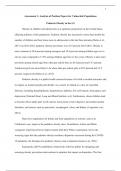1
Assessment 1: Analysis of Position Papers for Vulnerable Populations
Pediatric Obesity in the US
Obesity in children and adolescents is at epidemic proportions in the United States, affecting millions of this population. Pediatric obesity has increased to more than double the number of children and four times more in adolescents in the last three decades (Hales et al., 2017). In 2015-2016, pediatric obesity prevalence was 18.5 percent 2015-2016. Obesity is more common at 20.6 percent among teenagers and 18.4 percent among children ages six to eleven years compared to 13.9% among children aged two to five years. Obesity is also more prevalent among school-aged boys than pre-school boys at 20.4 percent and 14.3 percent. Adolescent girls are more likely to be obese than pre-school girls at 20.9 percent and 13.5 percent, respectively (Hales et al., 2017). Pediatric obesity is a public health concern because of its link to morbid outcomes and
its impact on mental and physical health. As a result, it's linked to a slew of comorbid illnesses, including hyperlipidemia, hypertension, diabetes, low self-esteem, sleep apnea, and depression (National Heart, Lung and Blood Institute, n.d). Furthermore, obese children tend to become obese adults later in life and are more prone to have digestive and cardiovascular disorders; and cancers such as pancreatic, oesophageal, colon, and kidney (Avgerinos et al., 2019). State-level regulations for drinks and food regulations in schools, such as in California's case, improve the pediatric obesity rates. Nonetheless, Latino and Black youngsters experienced lower improvements than their White counterparts. Given the worrying signs that the pediatric obesity incidence disparities increased during the COVID-
19 pandemic, the therapies for pediatric obesity need evaluation (Jensen et al., 2021).
Kumanyika (2019) established a framework with four pillars for designing and assessing obesity prevention interventions to optimize the impact on disparities. The four 2
pillars, which are increasing healthy options, reducing deterrents, improving social and economic resources, and strengthening community capacity, require comprehensive, multi-
level interventions to change the policies, systems, and environmental factors that drive disparities in overweight/obesity that are rooted in structural racism (Bleich et al., 2021).
Efforts to reduce sugar-sweetened beverage (SSB) intake, encouraging healthy behaviors, and
changes in the built environment in low-income communities are all promising evidence-
based strategies for reducing disparities in children that are overweight or obese (Bleich et al.,
20021). Despite governmental efforts adopted to reduce SSB use in many settings, most 5–
17-year-olds consume SSB daily, with Latino and Black children having the highest intake. This is a pattern driven by targeted marketing to these groups (Russo et al., 2020).
Role Of Interprofessional Team
This paper proposes the elimination of SSB marketing to children, increasing SSB taxes, mandating that all SSB have warning labels that indicate their harmful components, and requiring all schools to provide drinking water during lunch. Also, the Supplemental Nutrition Assistance Program funds should be provided to schools restricted to the non-
purchase of SSBs and encourage the purchase of vegetables and fruit (Tanskey et al., 2018). To effectively promote fairness, these programs should be in localities where minority children predominate and are likely to be obese. Additionally, local governments should build
or renovate local parks, making them ideal for safe children's play and to engage in physical activities (Vargas et al., 2017). Increasing children's physical activity is possible through accessible and creative measures, such as temporarily blocking streets (Umstattd et al., 2019). Cost is undoubtedly a factor in selecting an intervention selection, with cost-
effectiveness models suggesting three primary prevention interventions: an SSB excise tax,




